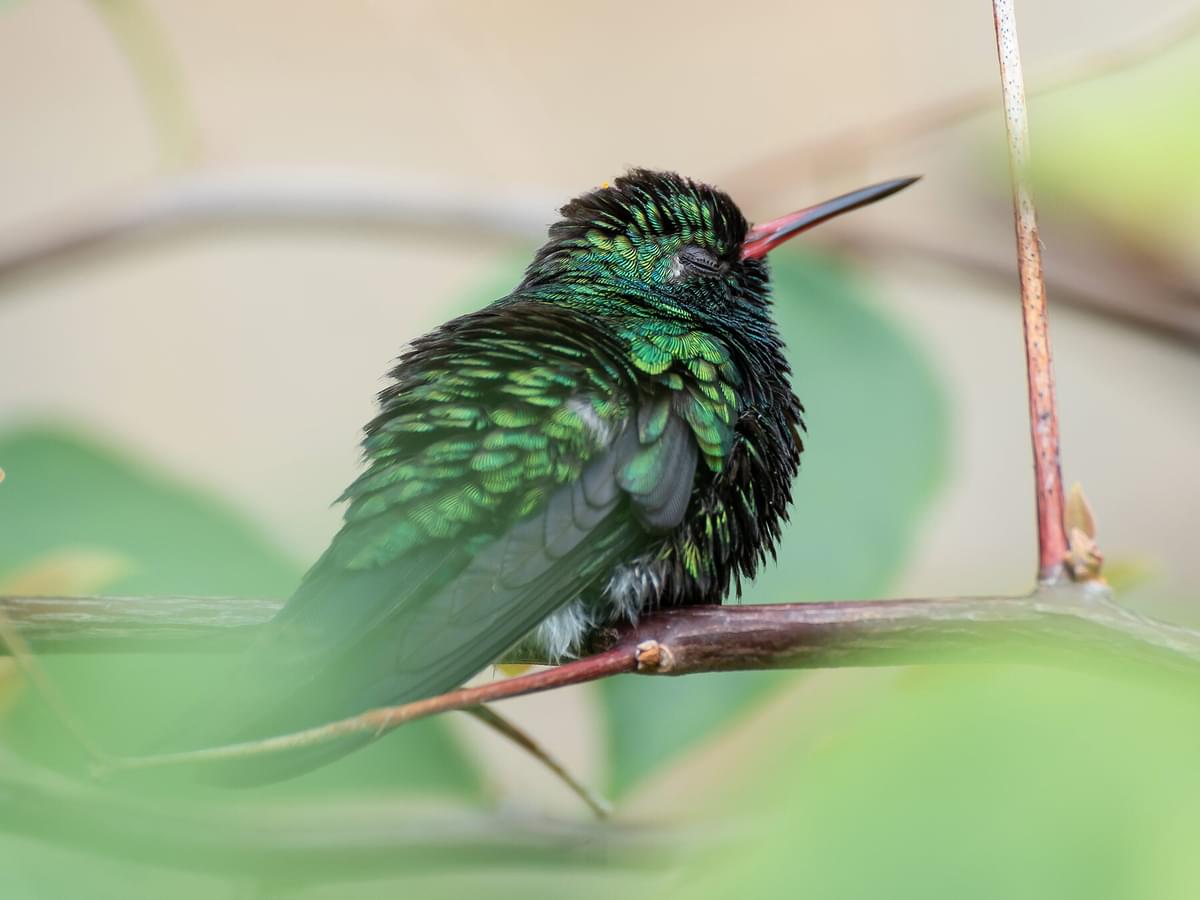Where Do Hummingbirds Sleep? (Everything Explained)
Last updated: 8 June 2022

The hummingbird may very well be one of the most fascinating bird species. They seem so fragile, and in some ways they are, but these tiny birds are also adapted to survive. An important part of their survival involves when and how a hummingbird sleeps.
Hummingbirds generally sleep at night by hanging upside down on a branch surrounded by dense vegetation. Protection from wind, cold, and rain is vital for the hummingbird to stay warm enough to survive. To maintain a consistent body temperature and conserve energy at the same time, this species will typically enter a state of torpor every night.
Torpor allows the hummingbird to rest from their high-energy day spent feeding. In this state, the bird’s metabolism slows significantly, allowing it to maintain just enough body heat to survive.
We will dive more in-depth into torpor and other hummingbird sleep facts throughout the article. Read on to discover more!

A sleeping Rufous Hummingbird
What time do hummingbirds go to sleep?
Hummingbirds cannot see very well in the dark. Thus, they sleep at night once there is no longer enough light to feed. Sleeping also allows them to recover the energy spent throughout the day.
These birds have extremely high metabolisms that keep them in seemingly constant motion. A hummingbird is either flying swiftly in search of food or hovering while they eat throughout the day. Their high sugar diets allow them to maintain this energy and sustain a consistent body temperature during the hours they are awake.
However, since they cannot feed at night, it is nearly impossible for these little guys to keep up enough energy to survive without going into torpor. Torpor is a sleep-like state that allows the bird to conserve energy by lowering its body temperature.
Unlike hibernation, a torpid state can be entered just for a night or on a really cold day.

A male Anna's hummingbird in flight
How long do hummingbirds sleep?
Hummingbirds generally sleep throughout the night, waking around dawn. Because these birds sleep in a torpid state, waking up can take a long time - sometimes up to an hour.
They slowly wake themselves by shivering. Shivering allows the hummingbird to generate more body heat to warm up. On average, hummingbirds need to maintain a body temperature between 104 and 108 degrees. During torpor, they sometimes drop their body temperature as much as 50 degrees below average.
If you find a hummingbird in torpor, it is important to leave them be. It may appear to be sick or dead, as breathing is generally not noticeable, but the bird will recover from its deep sleep on its own time.

A hummingbird taking a rest on a flower
Do hummingbirds sleep upside down?
Occasionally, hummingbirds sleep upright on a branch. However, individuals generally sleep upside down. They do so by hanging onto a limb that is well-protected from predators and the elements. These tiny birds have even been observed sleeping upside down on a feeder.
Do hummingbirds sleep in nests?
A hummingbird female will sleep on the nest while she is incubating eggs or brooding nestlings. This period could last several weeks from the beginning of incubation to when the chicks fledge. Otherwise, hummingbirds typically sleep in dense foliage.
During nesting season, the female hummingbird takes on all nesting responsibilities, from construction to caring for the young. The nest is generally an open cup constructed with plant matter placed in the fork of a branch.
Spiderwebs are used to make the nest more resilient and help hold it in place. Like the sites hummingbirds seek out to sleep, nests are built in dense foliage, protected from predators and inclement weather.

Hummingbird asleep on the nest
Where do hummingbirds sleep during migration?
Migrating hummingbirds find warm, heavily sheltered places to sleep at night. Generally, these birds seek out dense vegetation amongst trees and shrubs. Protection from wind, cold, and inclement weather is extremely important for these tiny creatures.
Do hummingbirds sleep during the day?
Hummingbirds typically sleep at night. However, on a particularly cold day, these birds will go into a state of torpor even when the sun is up. Maintaining a consistent body temperature between 104 and 108 degrees is vital to a hummingbird’s survival.
Hummingbirds have evolved to be efficient flyers, thus they do not possess thick, heavy feathers. Because of this, they must largely depend on their metabolism to keep their body temperature consistent.
If daytime temperatures are too cold, the bird will lower its metabolic rate and fluff up its feathers to retain as much heat as possible. This state of sleep, known as torpor, allows hummingbirds to stay just warm enough to survive without using as much energy as when they are fully awake.

Resting hummingbird on a branch
Hummingbird Sleep FAQs
Where do hummingbirds sleep when it's cold?
During cold weather, hummingbirds find a well-protected place to sleep. They typically perch or hang upside down from a twig surrounded by dense vegetation.
Where do hummingbirds sleep when it rains?
During inclement weather, hummingbirds find a warm, protected place to take shelter. Generally, this will be amongst thick foliage or other dense vegetation, and always on the downhill side of a tree.






